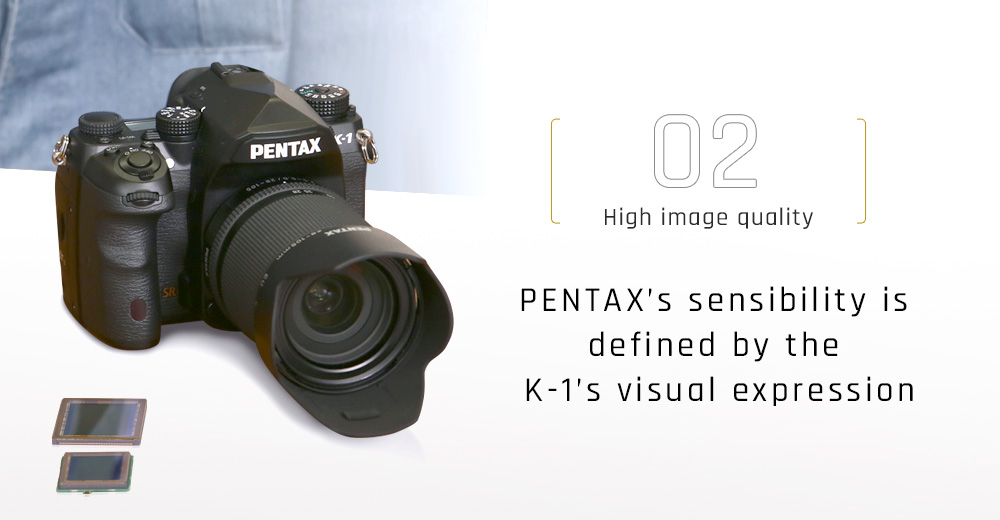
PENTAX has developed a solid policy for defining the image quality of a new SLR camera by optimizing the balance between image resolution and sensitivity. The PENTAX K-1 combines 36.4 effective megapixels with a top sensitivity of ISO 204800. It offers sensitivity far higher than the average for this grade of SLR camera. Why did PENTAX decide to provide the PENTAX K-1 with such high sensitivity? The PENTAX K-1’s design team talks about this decision.
“It’s not possible to achieve high sensitivity simply by reducing sensor noise, because the circuit configuration of the substrate to which the sensor is mounted greatly affects the type of generated noise. That’s why we designed an original substrate for the PENTAX K-1 by making the best use of our know-how.”
One of the PENTAX engineers in charge of sensor development held the PENTAX K-1’s image sensor unit in his hand. On the substrate beneath the image sensor, various components were neatly laid out, including the interface used to deliver control signals to the sensor and to send the sensor’s readout signals to the imaging engine. By fine-tuning the substrate’s configuration and optimizing its layout, he succeeded in upgrading the S/N ratio and characteristics of image data.
PENTAX achieved a combination of 16 effective megapixels and ISO 51200 with the PENTAX K-5, which was highly acclaimed for its outstanding image quality. In terms of pixel pitch, the PENTAX K-1’s image sensor is almost at the same level as that of the PENTAX K-5, and offers some extra room over the PENTAX K-3’s 24-megapixel sensor. This was where PENTAX’s expertise, gained over many years in the industry, became valuable for the development of this 35mm full-frame camera. After repeated fine-tuning, PENTAX successfully output RAW-format image data with very little noise. The next issue was how to make the best use of this RAW-format image data. The task of harmonizing high image quality with high sensitivity was left to the image processing team.

The key: resolving factors that can’t be expressed by numerical values

Even though the noise of RAW-format image data was reduced, the goal of ISO 204800, two steps higher than a top sensitivity of the PENTAX K-3 and PENTAX K-5, was still very difficult to reach. An engineer in charge of image processing spent most of his time fine-tuning a new noise-processing technology. The PENTAX image processing team believed that, by improving this technology, they could effectively eliminate the low-frequency noise, which is more noticeable in high-sensitivity photography.
If the team members had been concerned about the numeral assessment alone, they could have easily attained high sensitivity by suppressing all types of noise. The result, however, would have been flat images not only free of noise, but lacking in details and gradation. In scenic photography, for instance, every leaf of a tree should have subtle textures and its own original pattern. Even in high-sensitivity photography, he could not lose texture and reality by making the image too flat. What counted most was not the numerical values, but a good balance in the noise-processing stage that could make the most of the exceptional imaging power delivered by 36.4 effective megapixels.
“There are many ways to assess image quality. PENTAX has traditionally stayed away from the kind of image quality defined solely by excellent numerical assessment. It is probably because we regard sensory evaluation much more highly than most people would imagine.”
In the age of advanced technologies, PENTAX still places great importance on human sensibilities, something that is in complete opposition to much of today’s technological advancement. For PENTAX, this is the primary source for attaining exceptional image quality. Achieving this goal requires a large number of actual images capturing different types of subjects, and taken in varying photographic conditions. Among the PENTAX engineers are a group of photo enthusiasts specializing in such fields as portraiture, landscape and astronomical photography. Every weekend, they take test models out into the field, and shoot photographs without attracting people’s attention to the models that are still under development. In fact, this has become routine work for them.
The corporate environment supporting PENTAX-style image quality

Noise which one photographer doesn’t care about at all may be an annoyance too serious to overlook for another photographer. Details you think are fine may be unsatisfactory to your neighbor. Naturally, the standards and preferences of image quality vary from person to person. How, then, does PENTAX create its unique image-quality style?
PENTAX engineers have acquired a common perception of “target image quality,” without actually describing it in words. This was developed through numerous assessment meetings held by expert technicians from different fields. While it is true that human sensibility differs from one engineer to another, the preferred image quality started to take shape through an endless exchange of opinions. Unfavorable factors were clearly noted at the same time, and stored as the essential part of image quality assessment. All the engineers agreed that PENTAX was just the right size of company to make these exchanges of opinions possible.
Monday is the day to assess the images captured over the previous weekend by the team, using the test models. The image-processing team members take the results into account to improve noise-reduction and imaging performance, and then they go out on photo sessions again on the following weekend. For the development of the PENTAX K-1, they spent an enormous amount of time on this process. Only in the final stage of development did they become convinced that the goal of ISO 204800 was almost within their reach.
“A top sensitivity of ISO 204800 gives you greater flexibility in attaining the desired image quality at practical sensitivity levels. At ISO 12800, for instance, you take a glance at the image, and immediately notice that its detail and resolution are far better than those of previous SLR cameras, even though the perception of noise may vary from person to person. I’m confident that many people will agree with me on this point.”
PENTAX Blue: the color most prominent in 35mm full-frame images

A dramatic blue sky and lively green trees in scenic photography: the PENTAX K-1 inherits PENTAX Blue, a term affectionately used by Pentaxians (PENTAX camera enthusiasts). A technician in the image-processing team explains: “We are trying to create memory colors, rather than faithfully reproducing original colors. In particular, blues and greens are the colors that decide the impression of scenery. That’s why we work hard to reproduce rich, dramatic tones of these colors.” Although today’s SLR cameras provide a high-saturation mode in their default settings, the saturation level is more subdued now for most makers than it was earlier. In fact, PENTAX is probably the only manufacturer to offer such high saturation and rich tones.
“PENTAX’s Bright and Vibrant modes are often avoided by other manufacturers, because higher saturation and richer tones essentially result in more noise. However, it is our strength in image-processing technology that lets us maintain the same expression of noise regardless of a selected shooting mode. This is a tradition we are all proud of.”
Even though it may not sound technically logical, it is the mission of PENTAX engineers to deliver the colors desired and favored by Pentaxians. Today, a camera is a cluster of high technologies, which continue to advance day by day. PENTAX believes, however, that, no matter how advanced technologies may become, image quality is always something perceived by the human eye, and is the product of human sensibility. The PENTAX K-1 is the camera that reminds you of this indisputable fact!










